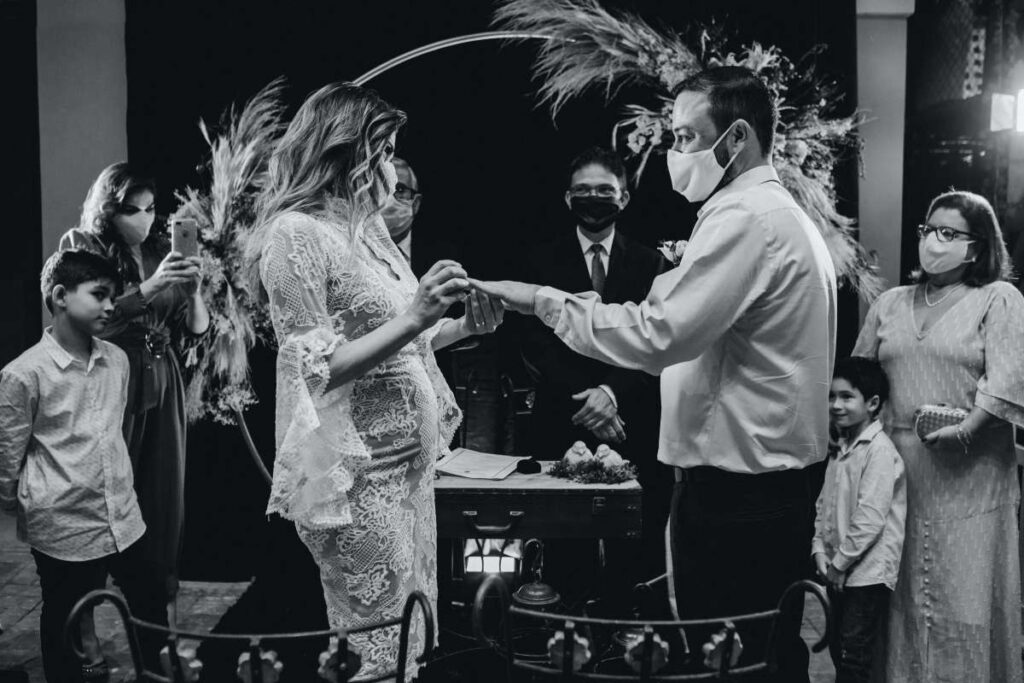When it comes to wedding planning, one of the most common questions couples face is: Who should pay for the wedding rings? Whether you’re sticking to tradition or taking a more modern approach, the answer isn’t always clear-cut. In this guide, we’ll explore the history behind who traditionally pays for the rings, how modern couples are reshaping this norm, and the key factors to consider when making this decision. From understanding costs to deciding on matching wedding bands, this article will provide all the insights you need to make the right choice for your relationship and budget.
Who Traditionally Pays for the Wedding Rings?
The Historic Role of Families in Purchasing Wedding Bands
When it came time for my partner and me to start planning our wedding, one of the first questions we tackled was: “Who should pay for the rings?” It’s funny to think about now, but I remember assuming the other would take care of it. This question really made me reflect on tradition and how it influences modern couples.
Traditionally, it was expected that the groom’s family paid for the bride’s wedding ring, while the bride’s family covered the groom’s. This practice was part of a broader family exchange, symbolising not just love but also unity between families.
- Wedding rings were traditionally worn by women until WW2, when soldiers started wearing them as symbols of connection to loved ones.
- In some cultures, wedding rings were part of a dowry system, where families played a significant role in financing the couple’s wedding.
Today, while the tradition has evolved, some couples still adhere to these customs, particularly in certain cultural or family settings.
How Modern Couples Are Changing the Tradition
Collaborative Approaches to Paying for Wedding Rings
As times have changed, so have expectations around who pays for the wedding rings. Today, many couples prefer to approach this as a shared experience. Personally, my partner and I decided to split the cost, and it felt like a fitting way to start our life together.
Here are some modern approaches:
- Each partner pays for the other’s ring: This is a romantic option, allowing each partner to surprise the other with a meaningful choice. I’ve seen couples choose this for the added personal touch.
- Splitting the cost evenly: For couples who have shared finances, this is a common choice. It ensures both partners contribute equally, avoiding any imbalance. It’s practical and fair.
- Each buys their own ring: This ensures that both partners get a ring that fits their personal style and budget.
Who Pays When There’s a Large Price Difference?
When there’s a significant income gap between partners, things can get tricky. I’ve worked with couples where one partner has a much higher income, and this often leads to one person covering more of the wedding expenses.
Here’s how this can work:
- One partner covers both rings: If one person can afford both rings, they might choose to cover this cost entirely.
- Splitting costs based on income: Some couples opt for a solution where the higher earner contributes more. This ensures that both partners feel like they’re contributing fairly without causing financial strain.
The key here is communication—discussing finances openly ensures both partners are comfortable with the arrangement.
Key Factors to Consider When Deciding Who Pays for the Wedding Rings
Open Communication: The Foundation of Financial Decisions
One of the most valuable lessons I’ve learned from my own wedding planning and from working with couples is the importance of open communication. Discussing who pays for the wedding rings isn’t just about money—it’s about setting the tone for financial decisions in your marriage.
Why is communication so important?
- It sets clear expectations early on.
- It helps avoid misunderstandings later.
- It creates a healthy foundation for future discussions about money.
I suggest that couples address this topic early to make sure everyone feels comfortable and understood.
Financial Situation and Practical Considerations
Your financial situation is central to this decision. When deciding who should pay for the rings, consider the overall wedding budget and each partner’s contribution. I’ve seen couples who decide to split the costs equally after assessing their joint finances, which worked well for them.
Consider this:
- If one person has already spent a large amount on the engagement ring, they might prefer to pay for both wedding bands.
- If both partners have separate finances, splitting the cost might make the most sense.
Be realistic about what you can afford, and make sure the decision doesn’t put unnecessary stress on your finances.
Family Contributions and Cultural Influences
While it’s less common today, family contributions can still affect the decision on who pays for the wedding rings. Some families, particularly in more traditional settings, may want to contribute to wedding expenses.
For example, one couple I worked with had the bride’s family offer to cover the rings, which was a meaningful gesture for them. It’s important to have an open conversation with family members if they’re involved, to ensure expectations are aligned with your own.
Wedding Ring Costs: What You Need to Know
Understanding the Price Range of Wedding Rings
Wedding ring prices can vary greatly depending on style, material, and design. I remember feeling overwhelmed by the options when I was shopping for our rings. The most basic wedding bands can be affordable, but as you add diamonds or special engravings, the prices climb quickly.
Here’s what to expect:
- Basic bands: These typically start at around $100-$500 for simple metal bands (e.g., gold or titanium wedding rings).
- More intricate designs: Adding diamonds or special engravings pushes the price to about $1,000-$3,000.
- Premium rings: Platinum, rose gold, or titanium wedding bands can range from $2,000-$5,000 or more for custom designs.
While prices vary, setting a realistic budget and sticking to it is key. Many couples also find affordable wedding rings by choosing lab-grown diamonds or alternative materials like titanium.
Budget-Friendly Options for Wedding Rings
If you’re looking to save on wedding rings, there are a few strategies that can help without compromising quality:
- Lab-grown diamonds: These are more affordable than natural diamonds but have the same appearance and durability.
- Alternative metals: Titanium, zirconium, and stainless steel offer durable, stylish alternatives at a lower price.
- Smaller or thinner rings: You don’t need a massive diamond or thick band to make a statement.
- Online shopping: Purchasing rings online can help you access better prices and a broader selection.
By considering these options, couples can find high-quality rings without breaking the bank.
Engagement Ring vs. Wedding Band: Which Costs More?
Typically, the engagement ring is more expensive than the wedding band, due to the larger diamond or gemstone. On average:
- Engagement rings: These can range from $3,000-$5,800 or even more.
- Wedding bands: These tend to be more affordable, with prices ranging from $550 to $1,100.
I’ve noticed that couples who’ve spent more on the engagement ring often opt for simpler wedding bands to keep the overall cost manageable.
When to Buy Wedding Rings: Timing Is Everything
Starting the Ring Shopping Process Early
It’s crucial to start shopping for your wedding rings at least 3-4 months before the wedding. This gives you time to choose the perfect rings, make customisations, and ensure proper sizing. I’ve seen couples who rushed their ring purchases, only to end up disappointed because they didn’t have time to consider their options thoroughly.
- 3-4 months before: Start researching and visiting jewellers.
- 2 months before: Finalise your ring choices.
- 6 weeks before: Ensure the rings are ready and sized properly.
This timeline ensures you’re not left scrambling in the last few weeks.
Should Wedding Bands Match? Exploring Style Preferences
Why Many Couples Choose Unique Wedding Bands
When it comes to whether or not wedding bands should match, there’s no one-size-fits-all answer. Many couples today choose to reflect their individuality in their rings, opting for styles that speak to their personal tastes. When I worked with a couple in Melbourne, one partner preferred a classic gold band, while the other wanted a modern platinum ring. They didn’t match, but both rings were beautiful and meaningful in their own way.
Here’s why some couples choose unique rings:
- Personal preferences: Each partner has different tastes and comfort needs.
- Symbolic connections: Rings don’t need to match to reflect a shared bond. Some couples use matching gemstones or engravings to tie their rings together symbolically.
The Practical Side of Wedding Ring Shopping
When to Buy Wedding Rings: Timing Is Everything
Starting early is key when it comes to wedding ring shopping. I can’t tell you how many couples I’ve worked with who leave this crucial part until the last minute and end up scrambling. Trust me, you don’t want to be running around in the final weeks leading up to your wedding trying to decide on the perfect ring.
Here’s a timeline to guide your wedding ring purchase:
- 3-4 months before the wedding: This is the time to start researching and visiting stores. If you’re after custom wedding rings, this is when you’ll need to start discussing designs.
- 2 months before the wedding: You’ll have had time to narrow down your choices. Now it’s time to order your rings, or if customising, to approve the final design.
- 6 weeks before the wedding: Ensure everything’s finalised, and make sure the rings are resized (if necessary). You don’t want to be left trying to sort out a resizing issue in the final weeks.
By giving yourself enough time, you can make the process fun and stress-free. Plus, you’ll be sure to pick out rings you’ll wear every day with confidence.
Choosing the Right Size and Design for Your Wedding Ring
I remember when I was choosing our wedding rings, size was one of the most important things we had to get right. The last thing you want is to get your wedding rings and realise that they’re too tight or too loose. Rings are meant to be worn every day, so comfort is key. I always recommend couples get their sizes professionally measured, and ideally, choose a ring design that suits their lifestyle.
Here are some key factors to consider:
- Comfort: Make sure the ring feels good to wear every day. A rounded band, for example, tends to be more comfortable than one with sharp edges.
- Ring size: Don’t guess! Visit a jeweller for proper sizing. If you’re buying a ring like an eternity band, keep in mind that resizing can be difficult.
- Material choice: Different metals wear differently. If you’re someone who works with their hands often, materials like titanium or stainless steel might be a good choice due to their durability.
Choosing the right material and design isn’t just about appearance; it’s about how it will feel day-to-day. A wedding band is a symbol of your commitment, and it should feel as good as it looks.
Should Wedding Bands Match? Exploring Style Preferences
Why Many Couples Choose Unique Wedding Bands
In my experience, matching wedding bands aren’t always a must. Sure, some couples love the idea of having identical rings, but many others prefer to choose rings that reflect their individual styles. I remember a couple I worked with in Melbourne, one partner chose a vintage wedding ring passed down from a family member, while the other went for a modern gold band. Despite their differences, both rings symbolised their unique relationship and personal styles.
Here’s why many couples go for unique wedding rings:
- Personal preferences: Every individual has their own style, and wedding rings are an opportunity to express that.
- Symbolism: Even if the rings are not identical, couples can use elements like engraving or matching gemstones to create a connection between their rings.
I’ve also seen couples that choose complementary rings—a rose gold band for one partner and a platinum wedding band for the other, both styled with the same diamond setting. It’s a subtle way to keep the connection while embracing individuality.
Tips for Finding Wedding Bands that Reflect Your Relationship
When picking out wedding rings, it’s important to find something that feels right for both of you. For me, this meant choosing something that would both complement my style and reflect my partner’s personality. That’s the beauty of wedding bands—they can be as unique as the love they represent.
Here are a few tips to make the selection process easier:
- Think about your lifestyle: If you work with your hands or live an active lifestyle, choose a material that’s durable. Titanium, platinum, and tungsten are strong options.
- Personalisation: If you want your rings to feel more personal, consider custom wedding rings. Many couples love designing their own, adding unique features like engravings or alternative gemstones that hold special meaning.
- Comfort over aesthetics: While it’s tempting to go for something flashy, remember that you’ll wear these rings daily. Make sure the band is comfortable for everyday wear.
My advice is to pick a ring that feels as meaningful as it looks. After all, it’s something you’ll wear forever!
Considerations When Deciding Who Pays for the Wedding Rings
Creating a Plan That Reflects Your Values and Style
At the end of the day, who pays for the wedding rings is ultimately up to you. There’s no single right answer—what matters most is finding an arrangement that works for you both. Whether you choose to share the costs equally or one person covers the entire expense, the process should feel fair and respectful to both partners.
The most important part of this decision is ensuring that the rings reflect your values and style. They’re a symbol of your commitment, and they should feel like a true representation of your relationship.
Key Takeaways:
- There’s no one-size-fits-all answer when it comes to who pays for the wedding rings. What matters is what feels right for you as a couple.
- Wedding rings can range from affordable options like titanium wedding bands to luxury designs with diamonds or custom engraving.
- Open communication is key to deciding who pays and ensuring both partners are on the same page.
- The design and material of the rings should reflect your individual styles and lifestyles.
- Don’t rush—start shopping for rings 3-4 months before the wedding to allow time for customisation and resizing.
Let’s Get Straight to the Point
When it comes to wedding rings, the question of who should pay is evolving. Historically, families were deeply involved, with the groom’s family paying for the bride’s ring and vice versa. Today, couples are increasingly splitting costs, buying each other’s rings, or contributing based on their income. Open communication and financial planning are key to ensuring a fair and stress-free decision. Factors like family traditions, personal preferences, and ring costs should all be considered. Whether choosing matching bands or unique designs, timing, and comfort should also play a role in your wedding ring purchase.




